Acetic acid traps can temporarily reduce mosquito numbers in your immediate area, but they won’t eliminate your mosquito problem entirely. These DIY traps use apple cider vinegar to attract mosquitoes while dish soap immobilizes them, achieving measurable population reductions in studies. However, they only target adult mosquitoes and miss the larval stage, meaning trapped insects are quickly replaced by new ones emerging from breeding sites. Understanding their mechanics and limitations will help you maximize their effectiveness.
What Science Says About Acetic Acid and Mosquito Behavior
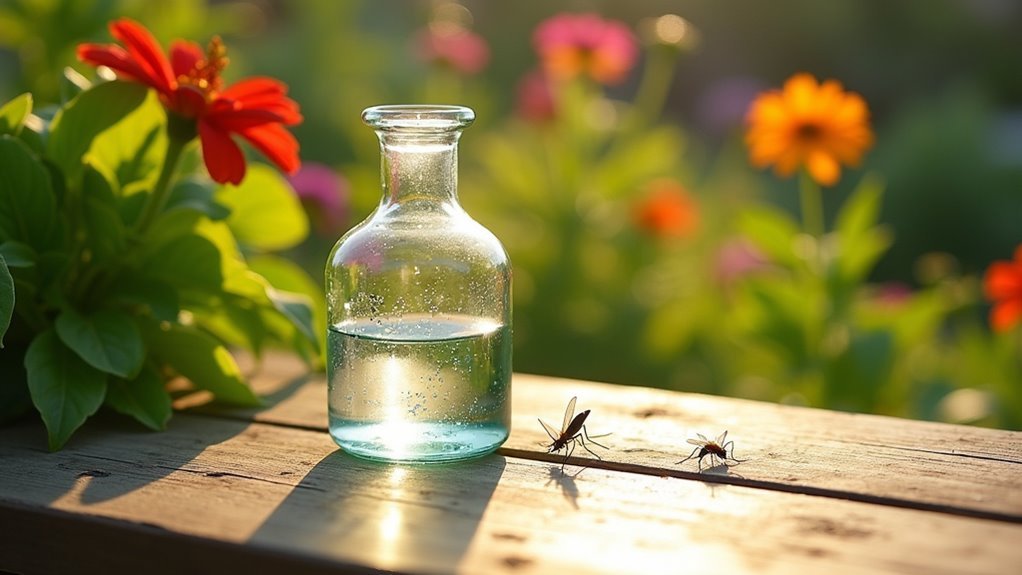
While mosquitoes navigate the world through complex sensory systems, acetic acid—the active compound in vinegar—disrupts their behavior in fascinating ways.
You’ll find that this simple household ingredient overwhelms mosquitoes’ scent receptors, creating an environment they actively avoid. Research reveals that wood vinegar containing acetic acid achieves nearly 100% repellency at ideal concentrations, while a 5% concentration provides roughly 40% effectiveness against these pests.
Wood vinegar with acetic acid demonstrates remarkable mosquito repellency, achieving nearly perfect effectiveness at optimal concentrations while maintaining significant protection even at lower doses.
The key lies in concentration levels—you must understand that high concentrations of acetic acid strongly repel mosquitoes, but low concentrations can actually attract them.
This dual nature affects their taste receptors negatively at proper strengths, making surfaces treated with concentrated vinegar solutions inhospitable to these unwanted visitors seeking blood meals.
How Acetic Acid Traps Actually Work
You’ve learned how mosquitoes react to acetic acid, but understanding the mechanics behind these traps reveals why they’re so effective.
The process combines vinegar’s natural attractant properties with clever trap construction methods that prevent escape once mosquitoes make contact.
Scientific studies back up these homemade solutions with concrete data showing measurable reductions in mosquito populations.
Vinegar’s Mosquito Repellent Properties
How does the humble vinegar in your kitchen cabinet transform into an effective mosquito repellent? The secret lies in acetic acid’s powerful smell that mosquitoes find absolutely repulsive.
When you apply vinegar as a mosquito repellent, you’re targeting their sensitive taste receptors, which react negatively to the acidic compound and deter them from landing on treated surfaces.
However, concentration matters greatly. Wood vinegar delivers up to 100% repellency at 80% concentration, while apple cider vinegar can actually attract mosquitoes at lower concentrations.
You’ll need frequent reapplication since the scent fades quickly, making vinegar a temporary solution. While it’s less effective than DEET or citronella oil, vinegar offers a natural alternative for short-term mosquito control.
Trap Setup Methods
Unlike vinegar’s repellent properties that drive mosquitoes away, acetic acid traps work by exploiting the opposite principle—they draw mosquitoes in and prevent their escape.
These traps use apple cider vinegar’s scent to attract mosquitoes, while dish soap creates surface tension that immobilizes them upon contact.
Setting up effective acetic acid traps for mosquito prevention requires proper technique:
- Mix one part apple cider vinegar with three parts water in a bowl
- Add several drops of dish soap to break surface tension
- Place traps in elevated areas to maximize scent dispersal
- Position multiple traps around your outdoor space for better coverage
While acetic acid traps successfully capture adult mosquitoes, they won’t eliminate larvae from breeding sites.
You’ll need complementary control methods for thorough mosquito prevention throughout your property.
Scientific Effectiveness Data
While acetic acid traps show promise for mosquito control, their effectiveness depends heavily on concentration levels and proper application.
Research demonstrates that 5% wood vinegar concentrations achieve approximately 39.6% repellency against mosquitoes, while higher concentrations can reach up to 100% effectiveness in laboratory studies.
You’ll find that acetic acid works through a dual mechanism – low concentrations attract mosquitoes to the trap, while higher concentrations repel them from treated areas. The compound affects mosquito taste receptors, making treated surfaces unappealing for landing and feeding, potentially reducing mosquito bites.
However, you’ll need regular maintenance since the scent fades over time, diminishing the trap’s ability to attract and capture mosquitoes effectively.
Setting Up Effective Vinegar-Based Mosquito Traps
Creating your own vinegar-based mosquito trap requires just a few common household items and takes only minutes to assemble. You’ll need apple cider vinegar, dish soap, and a plastic bottle to construct an effective mosquito trap that rivals commercial alternatives.
Start by mixing one part dish soap with three parts apple cider vinegar in your container. The vinegar attracts mosquitoes while the soap prevents their escape by breaking surface tension.
- Cut a plastic bottle and invert the top to create a funnel entrance
- Hang traps in elevated locations for better odor dispersion
- Replace the vinegar mixture every few days to maintain potency
- Position multiple traps around outdoor seating areas for maximum coverage
This non-toxic approach provides an environmentally friendly solution without harmful chemicals.
Measuring the Real-World Performance of Acetic Acid Traps
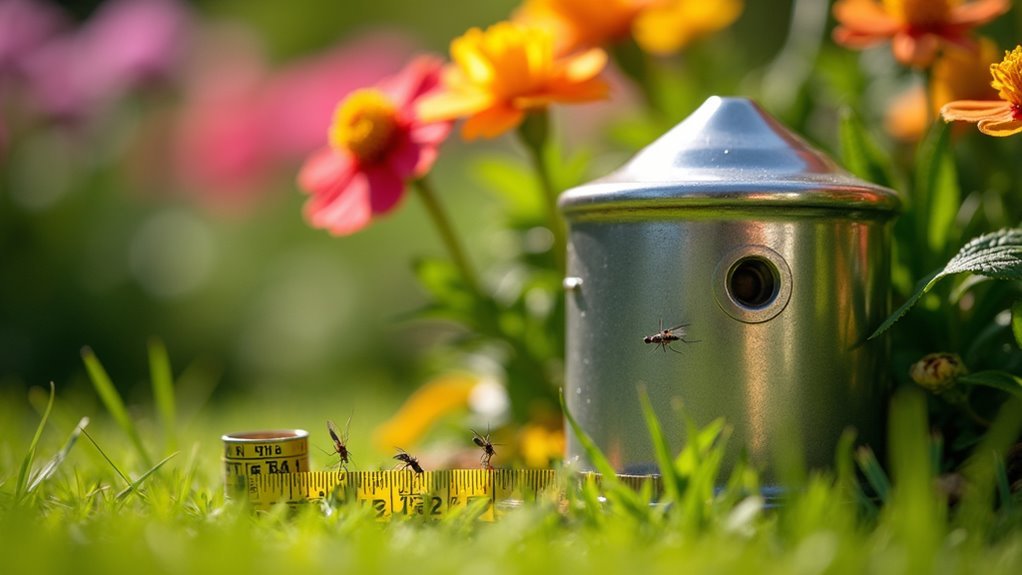
After you’ve set up your acetic acid traps, you’ll want to evaluate how well they’re actually working in your specific environment. Real-world performance varies greatly based on trap placement, acetic acid concentration, and environmental conditions.
You’ll achieve the best results by positioning traps in shaded or sheltered locations where mosquitoes naturally congregate.
Studies show that a 3:1 ratio of acetic acid to dish soap captures substantial numbers of mosquitoes in high-activity areas. However, you’ll need to maintain your traps regularly since the scent diminishes over time, reducing effectiveness.
Regular maintenance is essential for acetic acid mosquito traps since their effectiveness decreases as the scent weakens over time.
While these traps can keep mosquitoes at bay around specific areas, they won’t eliminate breeding sites or control larvae.
You’ll need a thorough approach combining acetic acid traps with other mosquito management strategies for maximum impact.
Why Acetic Acid Traps Have Limited Effectiveness
You’ll find that acetic acid traps face three major limitations that greatly reduce their mosquito control potential.
First, any repellent effects you observe are temporary at best, requiring constant reapplication to maintain even minimal effectiveness.
Additionally, these traps won’t address the root of your mosquito problem since they can’t eliminate larvae or prevent new populations from developing in nearby breeding sites.
Temporary Repellent Effects
While acetic acid traps might seem promising at first glance, they’re plagued by temporary repellent effects that severely limit their practical use.
You’ll find that these traps can temporarily repel mosquitoes due to their strong odor, but their effectiveness diminishes quickly as the scent fades over time.
- Short-lived protection – The repellent effects last only briefly before requiring frequent reapplication
- Impractical maintenance – You’ll need constant monitoring and refilling to maintain any protective benefits
- Contradictory attraction – At low concentrations, acetic acid actually attracts some mosquitoes rather than repelling them
- Surface-level solution – The traps don’t address mosquito larvae or breeding sites where populations originate
For an effective mosquito control strategy, you’ll need more reliable alternatives than acetic acid traps.
No Larval Control
Even when acetic acid traps successfully capture adult mosquitoes, they fail to address the root of the problem—mosquito larvae developing in standing water.
You’re only targeting adults while ignoring the breeding sites where new generations continuously emerge. This creates a cycle where trapped mosquitoes get quickly replaced by freshly hatched ones from untreated water sources.
Without disrupting the larval stage, you’ll never achieve lasting mosquito control.
That’s why you need products specifically designed for larvae, like BTI mosquito dunks that kill developing mosquitoes in their breeding water.
These biological treatments target mosquito larvae before they become flying pests, breaking the reproductive cycle that acetic acid traps can’t touch.
Effective control requires addressing both life stages simultaneously.
Requires Frequent Reapplication
Beyond targeting the wrong life stage, acetic acid traps demand constant maintenance that makes them impractical for long-term mosquito control.
You’ll find yourself repeatedly renewing vinegar-based solutions because the scent dissipates rapidly, leaving gaps in protection. Studies demonstrate that acetic acid’s mosquito repellent properties weaken considerably within hours, requiring frequent reapplication to maintain effectiveness.
This maintenance burden makes acetic acid traps less reliable than other proven repellents that offer extended protection:
- Quick scent dissipation – Vinegar’s odor fades rapidly, reducing repellent effectiveness
- Hours-long protection – Unlike long-lasting alternatives, acetic acid provides only short-term relief
- Constant renewing needed – You must consistently reapply solutions to maintain barriers
- High maintenance costs – Frequent reapplication increases time investment and material expenses
Combining Acetic Acid Traps With Other Control Methods
When you integrate acetic acid traps with other mosquito control strategies, you’ll create a more powerful defense system that addresses multiple aspects of mosquito management.
Since acetic acid traps only attract and immobilize adult mosquitoes without preventing larvae development, you’ll need to eliminate standing water sources like flower pots, gutters, and birdbaths where mosquitoes breed.
Combine your traps with professional pest control treatments for thorough coverage. Position traps in elevated areas away from competing scents while simultaneously using DIY repellents on your body.
This multi-faceted approach tackles both existing adult populations and breeding sites. Remember that acetic acid traps work best as part of an integrated pest management system rather than standalone solutions.
Better Alternatives to Acetic Acid for Mosquito Control
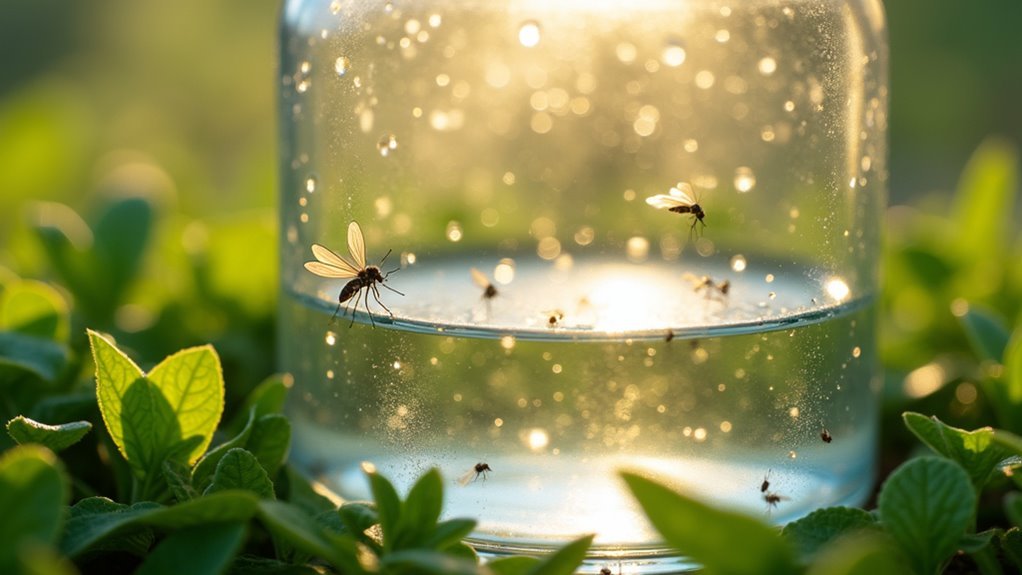
Several proven alternatives outperform acetic acid traps in mosquito control effectiveness and range.
When you’re seeking better alternatives to acetic acid for mosquito control, you’ll find multiple superior options available.
Essential oils like citronella, eucalyptus, and lemongrass work as excellent natural mosquito repellent solutions, offering pleasant scents while effectively deterring mosquitoes.
DEET provides longer-lasting synthetic protection that greatly outperforms acetic acid in both efficacy and duration.
Consider these superior mosquito control methods:
- Professional CO₂ and UV light traps that attract and eliminate mosquitoes at the source
- Bacillus thuringiensis israelensis (BTI) bacteria targeting mosquito larvae naturally
- Essential oil-based repellents providing effective natural protection
- Regular outdoor maintenance removing standing water and managing vegetation
These alternatives address mosquito problems more thoroughly than acetic acid traps alone.
Frequently Asked Questions
Do Vinegar Traps Work for Mosquitoes?
Vinegar traps can catch some mosquitoes when you mix apple cider vinegar with dish soap, but they’re not highly effective. You’ll need them as part of a broader mosquito control strategy.
Does Anything Actually Work to Repel Mosquitoes?
You’ll find DEET and lemon eucalyptus oil work best for repelling mosquitoes. They’re proven effective, unlike vinegar which provides only temporary relief. For serious protection, you should choose these established repellents over homemade solutions.
What Is Scientifically Proven Mosquito Repellent?
You’ll find DEET, picaridin, and oil of lemon eucalyptus are scientifically proven mosquito repellents. You can also use permethrin-treated clothing, IR3535, or 2-undecanone for effective protection against bites.
What Actually Stops Mosquitoes?
You’ll stop mosquitoes most effectively by eliminating standing water where they breed, using proven repellents like DEET, wearing protective clothing, and implementing professional pest control methods for thorough management.
In Summary
You’ll find that acetic acid traps don’t effectively stop mosquitoes on their own. While they can attract some mosquitoes due to the acidic scent mimicking human odors, they’re not reliable for significant population control. You’re better off using them as part of a thorough approach alongside proven methods like removing standing water, using EPA-approved repellents, and installing proper screening. Don’t rely solely on vinegar traps if you’re dealing with a serious mosquito problem.


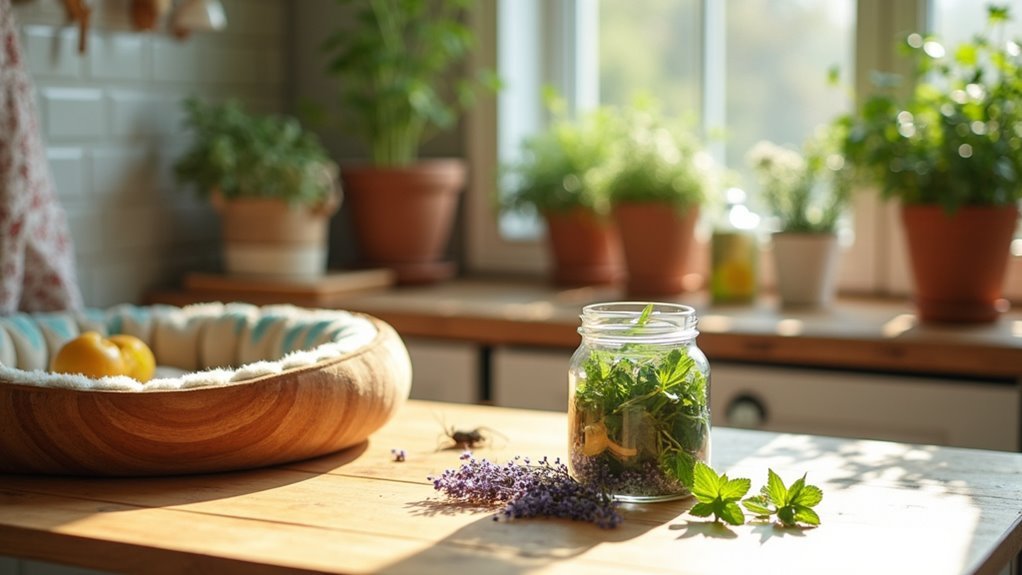

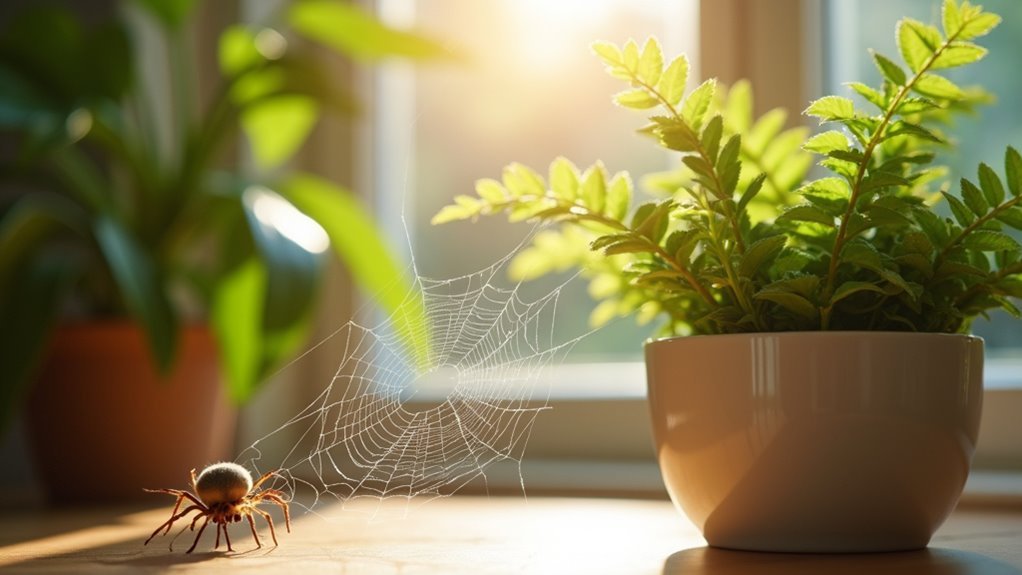
Leave a Reply